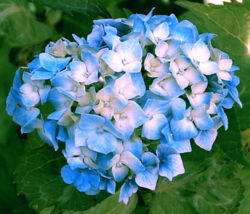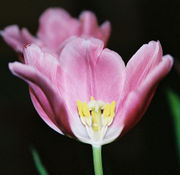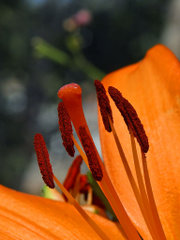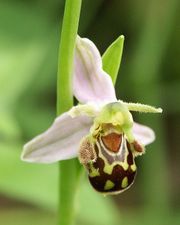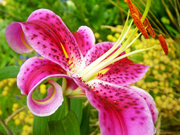Flower
2007 Schools Wikipedia Selection. Related subjects: Plants
A flower, (< Old French flo(u)r<Latin florem<flos), also known as a bloom or blossom, is the reproductive structure found in flowering plants (plants of the division Magnoliophyta, also called angiosperms). The flower structure contains the plant's reproductive organs, and its function is to produce seeds through reproduction. For the higher plants, seeds are the next generation, and serve as the primary means by which individuals of a species are dispersed across the landscape. After fertilization, portions of the flower develop into a fruit containing the seeds.
Flower function
The function of a flower is to mediate the union of male and female gametes in order to produce seeds. The process begins with pollination, is followed by fertilization, and continues with the formation and dispersal of the seed.
Flower anatomy
Flowering plants heterosporangiate (producing two types of reproductive spores). The pollen (male spores) and ovules (female spores) are produced in different organs, but the typical flower is a bisporangiate strobilus in that it contains both organs.
A flower is regarded as a modified stem (Eames, 1961) with shortened internodes and bearing, at its nodes, structures that may be highly modified leaves. In essence, a flower structure forms on a modified shoot or axis with an apical meristem that does not grow continuously (growth is determinate). The stem is called a pedicel, the end of which is the torus or receptacle. The parts of a flower are arranged in whorls on the torus. The four main parts or whorls (starting from the base of the flower or lowest node and working upwards) are as follows:
- Calyx – the outer whorl of sepals; typically these are green, but are petal-like in some species.
- Corolla – the whorl of petals, which are usually thin, soft and colored to attract insects that help the process of pollination.
- Androecium (from Greek andros oikia: man's house) – one or two whorls of stamens, each a filament topped by an anther where pollen is produced. Pollen contains the male gametes.
- Gynoecium (from Greek gynaikos oikia: woman's house) – one or more pistils. The female reproductive organ is the carpel: this contains an ovary with ovules (which contain female gametes). A pistil may consist of a number of carpels merged together, in which case there is only one pistil to each flower, or of a single individual carpel (the flower is then called apocarpous). The sticky tip of the pistil, the stigma, is the receptor of pollen. The supportive stalk, the style becomes the pathway for pollen tubes to grow from pollen grains adhering to the stigma, to the ovules, carrying the reproductive material.
Although the floral structure described above is considered the "typical" structural plan, plant species show a wide variety of modifications from this plan. These modifications have significance in the evolution of flowering plants and are used extensively by botanists to establish relationships among plant species. For example, the two subclasses of flowering plants may be distinguished by the number of floral organs in each whorl: dicotyledons typically having 4 or 5 organs (or a multiple of 4 or 5) in each whorl and monocotyledons having three or some multiple of three. The number of carpels in a compound pistil may be only two, or otherwise not related to the above generalization for monocots and dicots.
In the majority of species individual flowers have both pistils and stamens as described above. These flowers are described by botanists as being perfect, bisexual, or hermaphrodite. However, in some species of plants the flowers are imperfect or unisexual: having only either male (stamens) or female (pistil) parts. In the latter case, if an individual plant is either male or female the species is regarded as dioecious. However, where unisexual male and female flowers appear on the same plant, the species is considered monoecious.
Additional discussions on floral modifications from the basic plan are presented in the articles on each of the basic parts of the flower. In those species that have more than one flower on an axis—so-called composite flowers— the collection of flowers is termed an inflorescence; this term can also refer to the specific arrangements of flowers on a stem. In this regard, care must be exercised in considering what a ‘‘flower’’ is. In botanical terminology, a single daisy or sunflower for example, is not a flower but a flower head—an inflorescence composed of numerous tiny flowers (sometimes called florets). Each of these flowers may be anatomically as described above.
Floral formula
A floral formula is a way to represent the structure of a flower using specific letters, numbers, and symbols. Typically, a general formula will be used to represent the flower structure of a plant family rather than a particular species. The following representations are used:
Ca = calyx (sepal whorl; e.g. Ca5 = 5 sepals)
Co = corolla (petal whorl; e.g., Co3(x) = petals some multiple of three )
Z = add if zygomorphic (e.g., CoZ6 = zygomorphic with 6 petals)
A = androecium (whorl of stamens; e.g., A∞ = many stamens)
G = gynoecium (carpel or carpels; e.g., G1 = monocarpous)
x - to represent a "variable number"
∞ - to represent "many"
A floral formula would appear something like this:
- Ca5Co5A10 - ∞G1
Several other symbols are used that will have to await drawings to illustrate here (see ).
Pollination
Also see the main article on pollination.
The primary purpose of a flower is to join the pollen of one plant with the ovules of another (or in some cases its own ovules) in order to form seed which is genetically unique, allowing for adaptation to occur. As such, each flower has a specific design which best encourages the transfer of this pollen. Many flowers are dependent upon the wind to move pollen between flowers of the same species. Others rely on animals (especially insects) to accomplish this feat. Even large animals such as birds, bats, and pygmy possums can be employed. The period of time during which this process can take place (the flower is fully expanded and functional) is called anthesis.
Attraction methods
Many flowers in nature have evolved to attract animals to pollinate the flower, the movements of the pollinating agent contributing to the opportunity for genetic recombination within a dispersed plant population. Flowers that are insect-pollinated are called entomophilous (literally "insect-loving"). Flowers commonly have glands called nectaries on their various parts that attract these animals. Birds and bees are common pollinators: both having colour vision, thus opting for "colorful" flowers. Some flowers have patterns, called nectar guides, that show pollinators where to look for nectar; they may be visible to us or only under ultraviolet light, which is visible to bees and some other insects. Flowers also attract pollinators by scent. Many of their scents are pleasant to our sense of smell, but not all. Some plants, such as Rafflesia, the titan arum, and the North American pawpaw (Asimina triloba), are pollinated by flies, so produce a scent imitating rotting meat. Flowers pollinated by night visitors such as bats or moths are especially likely to concentrate on scent - which can attract pollinators in the dark - rather than colour: most such flowers are white.
Still other flowers use mimicry to attract pollinators. Some species of orchids, for example, produce flowers resembling female bees in colour, shape, and scent. Male bees move from one such flower to another in search of a mate.
Pollination mechanism
The pollination mechanism employed by a plant depends on what method of pollination is desired.
Entomophilous flowers (those which employ insects to transfer pollen) have an arrangement of the stamens that ensures that pollen grains are transferred to the bodies of the pollinator when it lands in search of its attractant (such as nectar, pollen, or a mate). In pursuing this attractant from many flowers of the same species, the pollinator transfers pollen to the stigmas - arranged with equally pointed precision - of all of the flowers it visits. Many flower rely on simple proximity between flower parts to ensure pollination. Others, such as the Sarracenia or lady-slipper orchids, have elaborate designs to ensure pollination while preventing self-pollination.
The flowers of other species are pollinated by the wind (for example, grasses); they have no need to attract pollinators and therefore tend not to be "showy". Wind-pollinated flowers are referred to as anemophilous. Whereas the pollen of entomophilous flowers tends to be large-grained, sticky, and rich in protein (another "reward" for pollinators), anemophilous flower pollen is usually small-grained, very light, and of little nutritional value to insects, though it may still be gathered in times of dearth. Honeybees and bumblebees actively gather anemophilous corn (maize) pollen, though it is of little value to them.
Flower-pollinator relationships
Many flowers have close relationships with one or a few specific pollinating organisms. Many flowers, for example, attract only one specific species of insect, and therefore rely on that insect for successful reproduction. This close relationship is often given as an example of coevolution, as the flower and pollinator are thought to have developed together over a long period of time to match each other's needs.
This close relationship compounds the negative effects of extinction. The extinction of either member in such a relationship would mean almost certain extinction of the other member as well.
Fertilization
Some flowers with both stamens and a pistil are capable of self-fertilization, which does increase the chance of producing seeds but limits genetic variation. The extreme case of self-fertilization occurs in flowers that always self-fertilize, such as many dandelions. Conversely, many species of plants have ways of preventing self-fertilization. Unisexual male and female flowers on the same plant may not appear or mature at the same time, or pollen from the same plant may be incapable of fertilizing its ovules. The latter flower types, which have chemical barriers to their own pollen, are referred to as self-sterile or self-incompatible (see also: Plant sexuality).
Seed production
Seed dispersal
Flower evolution
While land plants have existed for about 425 million years, the first ones reproduced by a simple adaptation of their aquatic counterparts; spores. In the sea, plants -- and some animals -- can simply scatter out little living copies of themselves to float away and grow elsewhere. This is how early plants, such as the modern fern, are thought to have reproduced. But plants soon began protecting these copies to deal with drying out and other abuse which is even more likely on land than in the sea. The protection became the seed...but not, yet, flowers. Early seed-bearing plants include the ginkgo, conifers (like pines), and fir trees. But the first fossil proof of actual flowers appears only 130 million years ago.
Unfortunately, there is no fossil evidence of exactly how flowers evolved; the evidence has them springing in advanced form into the fossil record. This was recognized almost immediately during the development of evolution theory, the strange appearance of flowers in the fossil record being called by Charles Darwin the Abominable Mystery.
The general assumption is that the function of flowers, from the start, was to involve other animals in the reproduction process. Pollen can be scattered without bright colors and obvious shapes, which would therefore be a liability, using the plant's resources, unless they provide some other benefit. One proposed reason for the sudden, fully developed appearance of flowers is that they evolved in an isolated setting like an island, or chain of islands, where the plants bearing them were able to develop a highly specialized relationship with some specific animal (a wasp, for example), the way many island species develop today. This symbiotic relationship, with a hypothetical wasp bearing pollen from one plant to another much the way fig wasps do today, could have eventually resulted in both the plant(s) and their partners developing a high degree of specialization. Island genetics is believed to be a common source of speciation, especially when it comes to radical adaptations which seem to have required inferior transitional forms. Note that the wasp example is not incidental; bees, apparently evolved specifically for symbiotic plant relationships, are descended from wasps.
Likewise, most fruit used in plant reproduction comes from the enlargement of parts of the flower. This fruit is frequently a tool which depends upon animals wishing to eat it, and thus scattering the seeds it contains.
While many such symbiotic relationships remain too fragile to survive competition with mainland animals and spread, flowers proved to be an unusually effective means of production, spreading (whatever their actual origin) to become the dominant form of land plant life.
While there is only hard proof of such flowers existing about 130 million years ago, there is some circumstantial evidence that they did exist up to 250 million years ago. A chemical used by plants to defend their flowers, oleanane, has been detected in fossil plants that old, including gigantopterids , which evolved at that time and bear many of the traits of modern, flowering plants, though they are not known to be flowering plants themselves, because only their stems and prickles have been found preserved in detail; one of the earliest examples of petrification.
The similarity in leaf and stem structure can be very important, because flowers are genetically just an adaptation of normal leaf and stem components on plants, a combination of genes normally responsible for forming new shoots . The most primitive flowers are thought to have had a variable number of flower parts, often separate from (but in contact with) each other. The flowers would have tended to grow in a spiral pattern, to be bisexual (in plants, this means both male and female parts on the same flower), and to be dominated by the ovary (female part). As flowers grew more advanced, some variations developed parts fused together, with a much more specific number and design, and with either specific sexes per flower or plant, or at least "ovary inferior".
Flower evolution continues to the present day; modern flowers have been so profoundly influenced by humans that many of them cannot be pollinated in nature. Many modern, domesticated flowers used to be simple weeds, which only sprouted when the ground was disturbed. Some of them tended to grow with human crops, and the prettiest did not get plucked because of their beauty, developing a dependence upon and special adaptation to human affection .
Uses by humans
Edible flowers
Flowers provide less food than other major plants parts (seeds, fruits, roots, stems and leaves) but they provide several important foods and spices. Flower vegetables include broccoli, cauliflower and artichoke. The most expensive spice, saffron, consists of dried stigmas of a crocus. Other flower spices are cloves and capers. Hops flowers are used to flavor beer. Marigold flowers are fed to chickens to give their skin a golden yellow colour, which consumers find more desirable. Dandelion flowers are often made into wine. Bee Pollen, pollen collected from bees, is considered a health food by some people. Honey consists of bee-processed flower nectar and is often named for the type of flower, e.g. orange blossom honey, clover honey and tupelo honey.
Hundreds of fresh flowers are edible but few are widely marketed as food. They are often used to add colour and flavor to salads. Squash flowers are dipped in breadcrumbs and fried. Edible flowers include nasturtium, chrysanthemum, carnation, cattail, honeysuckle, chicory, cornflower and sunflower. Certain edible flowers are sometimes candied such as pansy, daisy and rose.
Horticulture and floristry
Under Construction
Main and related articles at: Floristry, Flower garden, Gardening, Horticulture, and List of flowers
Flowers in the arts
The great variety of delicate and beautiful flowers has inspired the works of many poets, especially from the Romantic era. Famous examples include and William Wordsworth's I Wandered Lonely as a Cloud and William Blake's Ah! Sun-Flower.
Because of their varied and colorful appearance, flowers have long been a favorite subject of visual artists as well. Some of the most celebrated paintings from well-known painters are of flowers, such as Van Gogh's sunflowers series or Monet's water lilies.
The Roman goddess of flowers, gardens, and the season of Spring is Flora. The Greek goddess of spring, flowers and nature is Chloris.
Flowers in everyday life
In modern times, people have sought ways to cultivate, buy, wear, or just be around flowers and blooming plants, partly because of their agreeable smell. Around the world, people use flowers for a wide range of events and functions that, cumulatively, encompass one's lifetime:
- For new births or Christenings
- As a corsage or boutonniere to be worn at social functions or for holidays
- For wedding flowers for the bridal party, and decorations for the hall
- As brightening decorations within the home
- As a gift of remembrance for bon voyage parties, welcome home parties, and "thinking of you" gifts
- For funeral flowers and expressions of sympathy for the grieving
People therefore grow flowers around their homes, dedicate entire parts of their living space to flower gardens, pick wildflowers, or buy flowers from florists who depend on an entire network of commercial growers and shippers to support their trade.
Flowers as symbols
Many flowers have important symbolic meanings in Western culture. The practice of assigning meanings to flowers is known as floriography. Some of the more common examples include:
- Red roses are given as a symbol of love, beauty, and passion.
- Poppies are a symbol of consolation in time of death. In the UK, Australia and Canada, red poppies are worn to commemorate soldiers who have died in times of war.
- Irises/ Lily are used in burials as a symbol referring to "resurrection/life". It is also associated with stars (sun) and its petals blooming/shining.
- Daisies are a symbol of innocence.
Flowers within art are also representative of the female genitalia, as seen in the works of artists such as Georgia O'Keefe, Imogen Cunningham, Veronica Ruiz de Velasco, and Judy Chicago, and in fact in Asian and western classical art.

